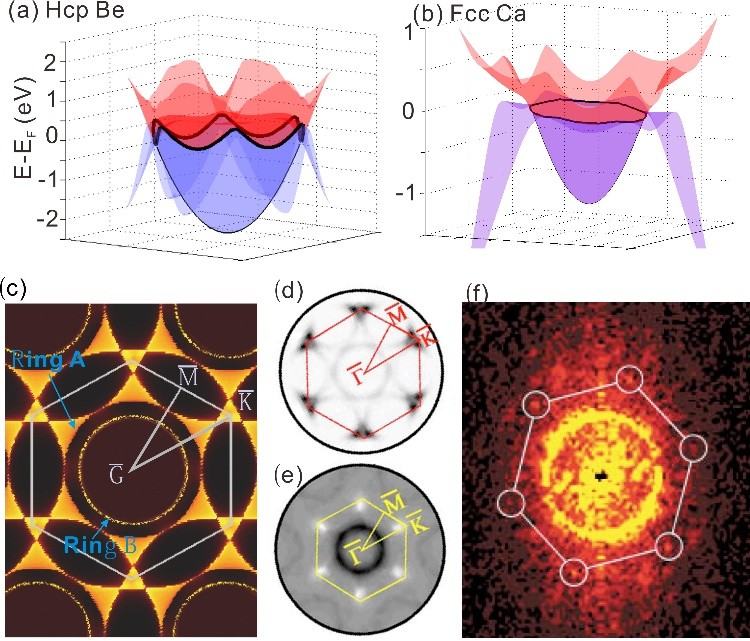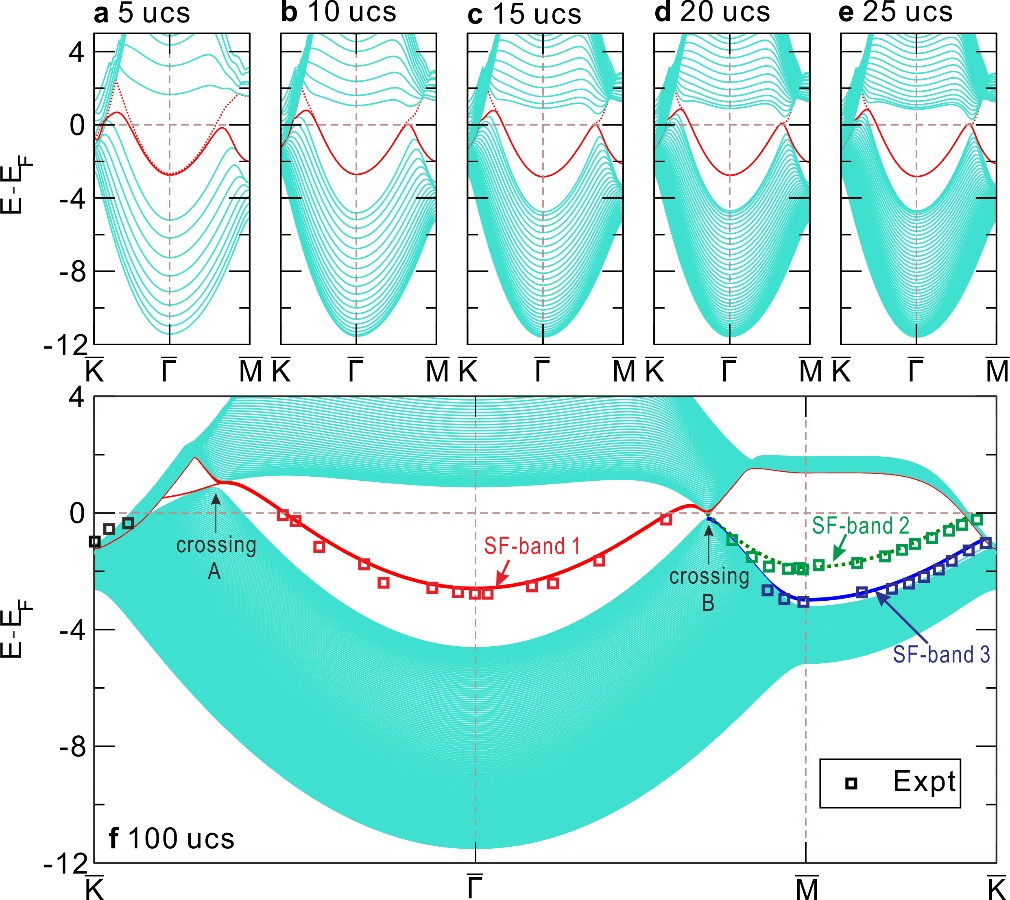研究背景:
金属单质铍具有十分罕见的性质,不但极轻高强,而且是优异的等离子体面向材料。与绝大多数其它金属单质不同,其表面态严重偏离近自由电子模型,并伴随着强电-声耦合效应和巨大的反常弗里德尔振荡。在过去的六十多年里,对金属铍奇异表面性质的机理探索从未停止,并引起了长期的争论。
创新成果及意义:
国家实验室工作人员研究表明,其特殊的表面电子能带结构来源于体材料中的拓扑狄拉克节线量子态。该类新的量子态是金属能带在费米能级附近线性交叉,在动量空间形成连续闭合的曲线,在(0001)表面的投影是一个闭合的圆,圆内则出现受体态保护半占据的拓扑非平庸能带,在费米能处出现极高的态密度。令人吃惊的是,这条拓扑非平庸的表面态从上个世纪八十年代起就先后被国际上诸多研究团队实验观察到,但当时其产生机理并未被揭示。基于拓扑狄拉克节线这个认识,金属铍的诸多特殊现象可以得到完美的解释,解决了长久以来困扰人们的科学谜题。
另外,这一发现也证实了拓扑狄拉克节线量子态的存在。近几年,在实际材料中寻找这种新的量子态成为广受关注的热门领域,虽然科学家先后在很多材料中预测存在这种量子态,但均未被实验验证。新结果证实了这种量子态诱发的拓扑非平庸表面态,为拓扑狄拉克节线量子态的存在提供了强有力的证据。
同时,研究还进一步发现该类型量子态也存在于镁、钙和锶等碱土金属单质中,理论结果也与实验吻合。这一特殊性质的发现打开了探索系列金属单质新奇拓扑性质的新方向。
上述研究成果发表在Physical Review Letters, 117, 096401 (2016).

Figure 1: Dirac node lines in hcp Be (a) and fcc Ca (b); (c) DFT-derived Fermi surface highlighting a surface state of a fully closed circle around the centered Γ point in the Brillouin zone; (d) and (e) The ARPES experimentally measured Fermi surfaces (see Phys. Rev. B, 72, 165414 (2005)); (f) The STM experimentally observed anomalously large Friedel oscillations on the Be (0001) surface (see Science,275,1765,(1997)).
Discoveries of Topological Dirac Nodal line States in Elementary Substance Systems of Rare-earth Metals.
A degenerate doublet with Fermi number ±1/2 was first predicted to exist in soliton by solving the Dirac equation as early as 1976. In 2011, the Dirac node line (DNL), defined as a closed loop consisting of continuous Dirac cones, was proposed to be correlated with such a degenerate doublet in condensed matters. Although this DNL feature was recently reported to occur in several compound systems, none of them has been experimentally realized.
Researchers from Shenyang National Laboratory for Materials Science (SYNL) have now made an important advance towards identifying the existence of DNL in experiment for pure beryllium metal through comparing results from first-principles calculations and those from previous photoemission spectroscopy studies of pure beryllium.
This work reveals that beryllium harbors the DNL induced by the s-->pz band inversion at the centre of the Brillouin zone, and the topology of the DNL results in the appearance of novel non-trivial surface states, a half-filled closed ring, as shown in the Be (0001) surface. In turn, the DNL and its induced topological surface states help to rationalize many of the histrionic debates on various intriguing surface electronic behaviors of Be metals, such as a severe deviation from a nearly free-electron gas, the giant electron density (or Friedel) oscillations, and Landau quantum oscillations. Beryllium also exhibits a giant surface electron-phonon coupling effect, which is also likely to be correlated with its DNL property.
They further revealed that each of the elemental alkali earth metals of Mg, Ca, and Sr also harbors the DNL, and speculated that the fascinating topological property of DNL might naturally exist in other elemental metals as well. In particular, because of extremely weak spin-orbit coupling effects in these alkali earth metals, the Dirac node lines will be highly robust against the decomposition into Dirac or Weyl fermions. Therefore, they provide a wonderful platform to investigate the related features of Dirac node lines.
The related work was published in the Physical Review Letters, 117, 096401 (2016).

Figure 2 The nontrivial topological surface electronic band structures of the Be (0001) surface in comparison with ARPES experimental measurements.
材料加工模拟研究部 Copyright© 2017 辽ICP备05005387号-9